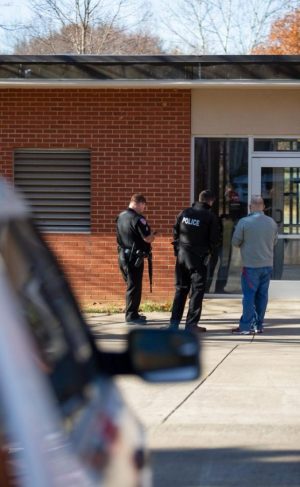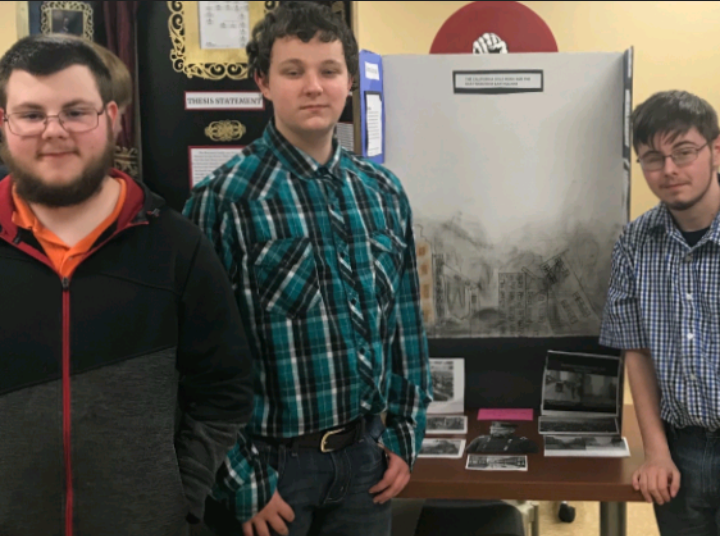OPINION: Gun violence hasn’t left, from a survivor of Marshall County
DJ Stover (right) stands with Pierson Salyers (left) and Michael Hovis (center) while attending high school. Pierson and Michael, friends of DJ, ran together from the shooting at Marshall County High School in 2018.
The high school I attended, Marshall County High School, was victimized by gun violence on Jan. 23, 2018. I started off the school day by walking through the main entrance and saying goodbye to my friends before heading off to my first block class.
As I walked into the classroom, I went and grabbed my laptop then sat on the couch. My friends piled in and sat down with me after grabbing their things. We talked and messed around like any high schooler would with their friends.
That’s when we heard the horde of students running down the hallway.
I thought it was a fire drill or alarm so I peeked outside the door. My friends behind me, I saw students with panic and terror in their faces. Tears running down their cheeks. We could hear the screaming. They were violently pushing open the double doors that lead outside.
We stepped into the hallway and saw our teacher running at us with a panicked look. She yelled at us to follow the students, so we did exactly that. We had no idea what was going on, but we knew everyone was running from the common area, so whatever happened originated there.
We got outside, and followed the crowd of students to the left of the building where we passed over a trampled fence. At that moment, I thought three things: What if I get crushed by the crowd? What if I injure myself crossing the fence? What happened to cause this?
We loaded onto buses lined up along the road, and my friends and I managed to enter the same one. I looked around at the faces of sadness, emptiness, anger. I felt nothing but confusion.
I texted my parents and heard another student say it was a shooting. They didn’t believe me at first but after seeing the news coverage, the fear set in.
The buses took everyone to the nearest elementary school, and they gathered us in the gym. For an hour or so, we all talked, cried or sat in silence waiting for our parents to pick us up. The school announced they were transporting us somewhere else so we got on the buses and went to a middle school in the next town over. Our parents were able to pick us up then.
I will never forget the look on everyone’s faces as I was walking out of the gym. I will never forget that day and the weeks after.
Unfortunately, MCHS isn’t the only school to go through this.
Less than a month later on Feb. 14, Marjory Stoneman Douglas High School in Parkland, Florida, also faced the terror. Then, three months later, the students at Santa Fe High School in Santa Fe, Texas, suffered a school shooting.
Since the Columbine High School shooting in 1999, gun violence and school shootings have become a fatal and devastating epidemic in the U.S., making high school or college campuses hazardous to attend.
After 1999, there have been a total of 304 school shootings in the U.S., whether that be on high school or college campuses.
David Riedman, Homeland Security Advanced Thinking Program co-founder and principal investigator for the K-12 School Shooting Database, told the New York Post in October 2021, “What we do know is across every demographic and region there is increasing gun violence bleeding over to school campuses.”
Aside from shootings, there have been threats towards campuses either by social media or verbally. Shooting threats are all over the news and social media.
In December 2021, a WKU student made a post on YikYak threatening a shooting near Pearce Ford Tower. The person stated “Shooting up pft around 4:30ish,” and added “Y’all gonna feel my pain.”
The police searched the student’s room but found no weapons. He was charged with terroristic threatening in the second degree.
According to USA Today, schools have been experiencing an increase of social media shooting threats and school violence threats since September 2021. In December 2021, numerous schools, from Minnesota to Texas announced they were closing in response to threats of school shootings and bombings on TikTok.
Little Falls Community School in Minnesota said it would close on Dec. 17 after the district said it was mentioned in a threatening TikTok video. Atlanta Public Schools in Georgia increased security that day.
There should be a push for universal background checks, mental health screenings and extra measures to ensure school shootings or mass shootings don’t occur on elementary, middle school, high school or college campuses.
The 1993 Brady Act requires anyone who wishes to purchase a gun from a licensed firearms dealer undergo a background check. Background checks may work for legally licensed firearm deals, but there are loopholes in this system.
Individuals who are prohibited from buying firearms legally can choose to buy from unlicensed dealers or private sellers. Many states have fought to close this loophole, but federal law does not require checks to take place in private transactions.
According to ABC News, a 2019 study by Boston University and Harvard University medical researchers found that U.S. states with universal background checks for all gun sales had homicide rates 15% lower than states without those laws.
Controlling arms sales is not the only way to prevent violence. Onlinetherapy.com surveyed 1,250 Americans in August 2021. 49% said the federal government should implement a law requiring mental health evaluations for anyone wanting to purchase a firearm.
Dr. Ira Glick, a professor of psychiatry and behavioral sciences at Stanford University, and his team studied 35 mass shootings cases that occurred in the U.S. between 1982 and 2019. Their research showed that 28 of the shooters had a mental illness diagnosis.
Unfortunately, none of those shooters were treated or were seeking treatment prior to their crimes.
Violence in schools is often handled in a reactionary way, rather than proactively. Schools who are threatened or victimized by gun violence often implement extra security measures afterwards to ensure something like that never happens again. This happened at Marshall County High School and Marjory Stoneman.
However, this has the potential to create new pressures and worries among students.
University at Buffalo education professor Jeremy Finn and Canisius College psychology professor Tim Servoss in 2015 studied data from 700 American high schools and three national surveys to analyze the impact of enhanced security measures, such as cameras, police patrols, metal detectors and drug surveillance.
The results showed that increasing security often results in students feeling more stressed, as well as higher rates of suspensions and arrests that disproportionately affect African American students.
Instead of extra security, one effective way to prevent shootings is the use of threat assessments and intervention teams. Threat assessments are designed to help schools assist students with grievances or mental health needs.

College campuses pose different challenges that may require a more constant security presence.
Umpqua Community College, a public college where 17 were shot in 2015, had campus security consisting of three full time officers, one part time officer and a supervisor. When the shooting took place at Umpqua, only two officers responded.
WKU is lucky to have the WKU Police Department, consisting of 21 officers in total. WKUPD were quick to respond to the Pearce Ford Tower shooting threat last semester.
After the Marshall County shooting, I didn’t know what to do or expect in the following week. Everyone I knew was in shock. The shooting affected my small community in ways we couldn’t comprehend at the time. We were all in a state of confusion and mourning, on edge and scared of what could happen next. No student in any American school system should have to worry like we did.
It wasn’t until years later as a junior that I started to research more about gun control, gun violence, school shootings and prevention methods. I knew something had to change. Laws need to change and our treatment of others needs to change. The way we deal with shootings needs to change.
It wasn’t until then that I became a strong advocate for stricter gun laws and better awareness of mental health. These are what keeps students all around the U.S. safe.
Being a victim in a close, compassionate community impacts you in ways you can’t imagine. The experience is life changing, scary, hard and unimaginable. Though it may appear a daunting task, stronger gun laws and better mental health treatment are necessary to combat this national threat to student safety.
Commentary writer DJ Stover can be reached at david.stover976@topper.wku.edu. Follow him on Twitter through @DeJayeJJ.





